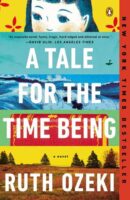A Handshake Between Time Periods
It’s incredibly rare that a novel can leave you feeling as ecstatically powerless as Ruth Ozeki’s A Tale For The Time Being, a strikingly well-crafted novel following the tribulations of both Naoko Yasutani, an early 2000’s teenager and of the more contemporary character of Ruth—an uninspired author reading the diary of the aforementioned Japanese teen.
Ozeki’s texts demonstrate a handshake between two separate periods within time, misting and tearing apart any conceptions of what it means to be ‘contemporary.’ The reader is simultaneously inundated with early references to popular and zany Japanese Maid Cafès and Hello Kitty merchandise (a Japanophile’s dream) in the form on Nao’s diary whilst Ruth provides a far more grounded account of modern normality—one of mundane and domesticated living.
When reading from the perspective of Nao, a readership is forcefully delved into an environment mostly motivated by suicidal thoughts. Being a Western reader, it became increasingly intriguing to be given some understanding into a Japanese mindset in regards to the romantic sentiments surrounding self-killing, one very foreign to my own.
On the other side of the coin, however, Ruth is a character who lives a decade or so after Nao’s accounts, the physical embodiment of dramatic irony. As a reader of Nao’s diary, she can locate Nao within time, using the internet as a tool to fixate her somewhere after 2001 but prior to the Fukushima Nuclear Reactor Incident of 2011—she’s a literary archaeologist of sorts. It is through Ruth that I, the reader, was stripped of all control. It is at Ruth’s pace of reading that we unveil the life of Nao, it is only at the will of her determination that I found myself turning the page, heavy with anticipation.
A Tale for the Time Being by Ruth Ozeki. Penguin Random House, 2013.
Reviewer bio: I’m Jack Graham, currently studying my Masters in English Literary Studies at Durham University.
Buy this book from our affiliate Bookshop.org.





